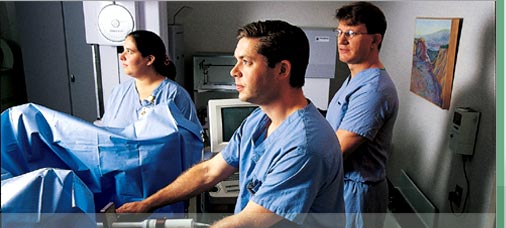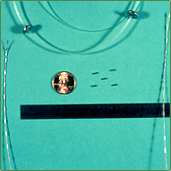 |
Make a secure online referral
here Oklahoma CyberKnife Information
|
 |
|
Brachytherapy Treatments Brachytherapy, also called internal radiation or seed implants, is the placement of radioactive sources in or just next to a tumor. The radioactive sources may be left in place permanently or only temporarily, depending upon your cancer. To position the sources accurately, special catheters or applicators are used. Because the radiation sources are placed so close to the tumor, your doctors can deliver a large dose of radiation directly to the cancer cells with minimal exposure to normal tissue.
There are two main types of brachytherapy: intracavity treatment and interstitial treatment. With intracavity treatment, the radioactive sources are put into a space near where the tumor is located, such as the cervix, the vagina or the windpipe. With interstitial treatment, the radioactive sources are put directly into the tissues, such as the prostate. Often these procedures require anesthesia and brief hospitalization. Patients with permanent implants may have a few restrictions at first and then can quickly return to their normal activities. Temporary implants are left inside of your body for several hours or days. While the sources are in place, you will stay in a private room. Doctors, nurses and other medical staff will continue to take care of you, but they will need to take special precautions to limit their exposure to radiation. Devices called high dose rate remote afterloading machines allow radiation oncologists to complete brachytherapy quickly, in about 10 to 20 minutes. Powerful radioactive sources travel through small tubes called catheters to the tumor for the amount of time prescribed by your radiation oncologist. You may be able to go home shortly after the procedure. Depending on the area treated, you may receive several treatments over a number of days or weeks. Most patients feel little discomfort during brachytherapy. If the radioactive source is held in place with an applicator, you may feel discomfort from the applicator. There are medications that can help this. If you feel weak or queasy from the anesthesia, your radiation oncologist can give you medication to make you feel better. |
| Radiation Oncology Consultants, Tulsa, OK. Hillcrest Medical Center - Helmerich Bld., 1120 S Utica, Tulsa, OK 74104. Phone: 918-579-8200 |
|
 The radioactive sources used in brachytherapy, such as thin wires, ribbons, capsules or seeds, come in small sealed containers. Some sources are placed permanently and are referred to as implants. These radioactive sources remain in the body after their radiation has been expended and the source is no longer radioactive. Other sources are placed temporarily inside the body, and the radioactive sources are removed after the prescribed dose of radiation has been delivered.
The radioactive sources used in brachytherapy, such as thin wires, ribbons, capsules or seeds, come in small sealed containers. Some sources are placed permanently and are referred to as implants. These radioactive sources remain in the body after their radiation has been expended and the source is no longer radioactive. Other sources are placed temporarily inside the body, and the radioactive sources are removed after the prescribed dose of radiation has been delivered.